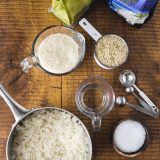For something as simple as the perfect pot of rice, you’d think the answer would be obvious. And yet, there’s little agreement on the best method. To soak? To rinse? How much water? Start the rice in cold water, or drop it in at a vigorous boil? Drape the pot with a towel at the end?
To settle what’s best, we prepared batches of the most common varieties using multiple methods. We quickly determined we could dispense with some steps we’d always assumed were essential.
We did away with soaking the rice before cooking—we found it did nothing to improve the rice’s texture. Same for setting a towel over the finished pot of cooked rice in order to absorb excess steam. So long as the rice was cooked in the proper volume of water (more on that in a moment), both steps were unnecessary.
We did, however, stick with rinsing the rice before cooking. With all varieties, we found this improved the texture of the finished rice. That’s because rinsing washes away excess starch that otherwise is shed into the cooking water and results in gluey, clumpy rice.
The ratio of water is where things diverged. Plain long-grain white rice required more water than jasmine rice, which has smaller, more delicate grains. Meanwhile, hearty brown rice cooks best when boiled in ample water, similar to pasta. That’s because grains of brown rice— which still contain the outer layer of bran and germ—absorb water unevenly unless fully submerged throughout cooking.
And in most cases (the exception being brown rice), the rice cooked best when it was added to cold water, then brought to a boil at medium-high, before being reduced to a simmer until cooked. Higher temperatures produced gummy exteriors and undercooked centers, while lower temperatures prolonged cooking so much the rice turned mushy.
The tough outer germ and bran of brown rice can make cooking it a challenge. For even cooking, boil it in abundant water as you would pasta to ensure the grains are surrounded by water throughout cooking.




